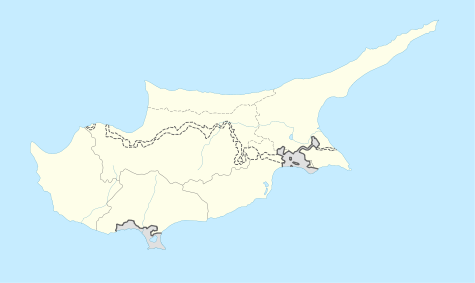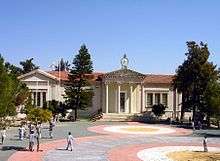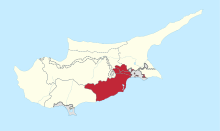Lefkara
| Lefkara Λεύκαρα | |
|---|---|
 | |
 Lefkara | |
| Coordinates: 34°52′N 33°18′E / 34.867°N 33.300°E | |
| Country |
|
| District | Larnaca District |
| Elevation | 500 m (1,600 ft) |
| Population (2001) | |
| • Total | 1,100 |
| Time zone | EET (UTC+2) |
| • Summer (DST) | EEST (UTC+3) |
| Postal code | 7710 |
| Website | http://www.lefkara.org.cy/ |
Lefkara (Greek: Λεύκαρα) is a village on the island of Cyprus famous for its lace, known as lefkaritika in (Greek: λευκαρίτικα) and silver handicrafts. The village takes its name from the white of its silica and limestone: Lefkara is derived from a combination of the Greek words "lefka" (Greek: λευκά, Translation: white) and "ori" (Greek: όρη, Translation: mountains, hills).[1] It has been listed among "The 30 most beautiful towns in Europe" by the Japanese Association of Travel Agents.[2]
Location
The village is located on the southern slopes of the Troödos Mountains in the Larnaca District of Cyprus, off the main Nicosia-Limassol highway. It features cobbled streets and picturesque architecture. The village is split into two administrative regions: upper and lower Lefkara (Greek: Πάνω & Κάτω Λεύκαρα) with around 1,100 inhabitants.
Silver & Lace
A common sight is groups of women who sit in the narrow village streets working on their fine embroidery, as they have for centuries. The village is also known for its skilled silversmiths who produce fine filigree work. A folklore museum in the town shows visitors what life was like in Cyprus about hundred years ago. The museum is located in a restored house and exhibits the furniture and effects of a wealthy family, local costumes and examples of the Lefkara lacework. According to legend, Leonardo da Vinci visited the village in 1481, and purchased a lace cloth for the main altar of the Duomo di Milano.[3][4][5] In 1889 a local lace school was opened, and Lefkara lace regained much of its ancient renown.[6]
Historical overview

Antiquity to the end of the Ottoman period
The Neolithic archaeological remains found in the village are proof that the region around Lefkara has been inhabited uninterruptedly for many centuries. The first historical testimony of the existence of Lefkara with its present-day name is found in the testament of Saint Neophytos, born in 1134 in the village of Kato Drys near Lefkara, when Cyprus was part of the Byzantine Empire. The house, which consists of just a single room, where Saint Neophytos met with his wife-to-be the night before he ran away to become a monk, still stands. Although a newer house has been built around it, it is now unoccupied and owned by Mrs. Maritsa Kallou. During the Frankish and Venetian period (1191-1571) Lefkara became a fiefdom. In the 16th century, it was the largest town in Cyprus. From 1571 to 1878 Cyprus was occupied by the Turks. Most of the houses conserved today in the village date from this period. The bare stone façades with few openings, the layout of rooms around an inner courtyard and the flat rammed-earth roofs are typical elements of the architecture of Lefkara until the late 19th century.
British period and independence

In 1878, Cyprus came under British Administration, following the Cyprus Convention and the Treaty of Berlin of that year. Starting in the early 20th century, the commercialisation of local embroidery sold all over Europe by the people of Lefkara produced major changes. Dating from this period are the two-storey houses with shops on their ground floors, sloping ceramic tiled roofs and long balconies running the length of main façades rendered in coloured plaster and decorated with period neoclassical architectural elements.21 nil
World War II interrupted the sale of embroidery, which never recovered. The shortage of work forced inhabitants to emigrate en masse and in the 1930s half of the village of Lefkara was left uninhabited.
In 1960, small Cyprus finally gained independence. Tourism began to develop in the 1970s, saving Lefkara from economic ruin. With traditional architecture still intact, embroidery and artisan silverwork attracted tourists.
Civic obstacles
The exodus of the population of Lefkara in the 1930s through to the 1970s resulted in the abandonment of many of the dwellings in the village. The development of tourism has had little impact upon the traditional architecture. The use of new materials chosen for reasons of comfort and fashion has changed little the façades and interiors of traditional dwellings. There are a number of dwellings that have remained untouched and are now closed up and uninhabited. For the most part, the traditional architecture of Lefkara remains intact.
Conservation and architectural heritage
Numerous traditional houses have been listed by the Department of Antiquities and the Department of Housing and Urbanism. Since 1978, several buildings have been rehabilitated by the Department of Antiquities, most particularly the Patsalos residence, which has been converted into a local museum of embroidery and traditional silverwork. A rehabilitation decree issued by the Department of Housing will include all traditional buildings pending listing.
International relations
Twin towns — Sister cities
Lefkara is twinned with:
References
- ↑ Official website site of Lefkara Municipality
- ↑ The 30 most beautiful towns in Europe
- ↑ 500th Anniversary of Da Vinci's visit to Cyprus
- ↑ Lefkaritika: Delicate Lace of Cyprus
- ↑ "Da Vinci" lace seeks a new lease in Cyprus
- ↑ Lefkara Lace embroidery and silver handicrafts
- ↑ "Twinnings" (PDF). Central Union of Municipalities & Communities of Greece. Retrieved 2013-08-25.
External links
- Official website of the Community Council of "Lower Lefkara" (Kato Lefkara)
- Images and more information about Lefkara in the 20th century
- Lefkara Association in America
Coordinates: 34°52′0″N 33°18′25″E / 34.86667°N 33.30694°E
